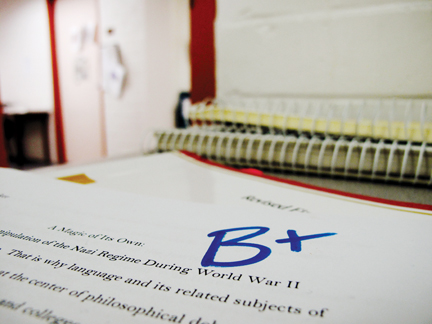Plus/minus grading fails without total application

After Peter Austin, assistant professor of University Programs, completed a study that found that more than 80 percent of surveyed schools employed a plus/minus grading scale, the St. Edward’s University Faculty Senate began deliberating the implementation of such a system on campus.
If a plus/minus system can be applied and used fairly across the entire university, then it should be implemented. Currently, the grading system needs more definition. Letter grades—A+, A, A- and so on—are self-explanatory, the faculty senate would need to determine how these letters would translate into a numbered scale for a four-point GPA. So far, none of these particulars have been established.
The faculty senate conducted a referendum of the faculty on the issue. According to James Payne, associate professor of political science, the majority of the faculty did not vote in the referendum. The results came back that 60 percent of the faculty are in favor of an optional plus/minus grading system.
Implementing a plus/minus system could increase the value of a St. Edward’s degree, help those in the future who want to pursue graduate school, law school or any other higher degree program and create a fair distinction between those who make an 80 in a class and those who make an 89—just a few of the reasons why a plus/minus grading scale is an excellent idea.
However, this system is only beneficial if it is properly and fairly implemented.The plus/minus grading scale cannot be optional for faculty use. The possibility of an optional plus/minus scale would create the chance that two students doing the same work in the same class taught by different professors could potentially earn the same numerical grade but different letter grades, which would hinder the equality in grading the system hopes to achieve.
Without a mandatory plus/minus system, an influx of students will search for professors that do not use plus/minus, complicating the registration process.
A secondary issue, one that Baylor University resolved, involves eliminating pluses and minuses in the A grade category. An A- cannot exist without the possibility of achieving its counterpart, an A+. A fair system would make an A+ more valuable than an A, disrupting the four-point scale.
To remedy this problem, the plus minus grading scale could begin with a B+ and continue downwards.
Lastly, current students at St. Edward’s should not be subject to a change in the academic bulletin unless it occurs during the semester they enter. Otherwise, current student’s GPA will be skewed, and dissention will ensue.
A plus/minus grading has significant merit, but in its current incarnation would make an adequate system worse. We should look to improve our grading system and in turn the worth of a student’s degree, and that happens through a fair, sensible and uniformly executed plus/minus system.






